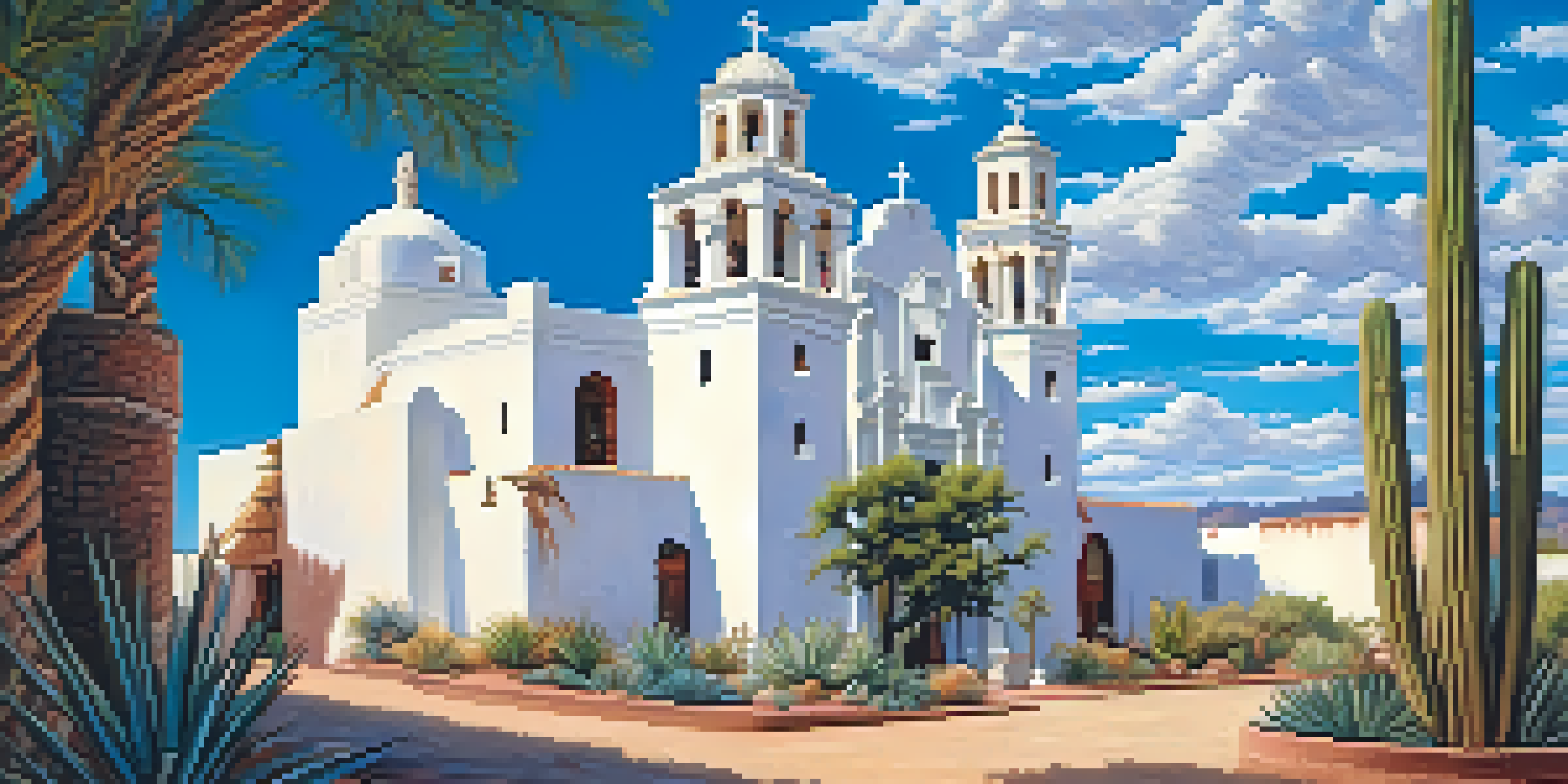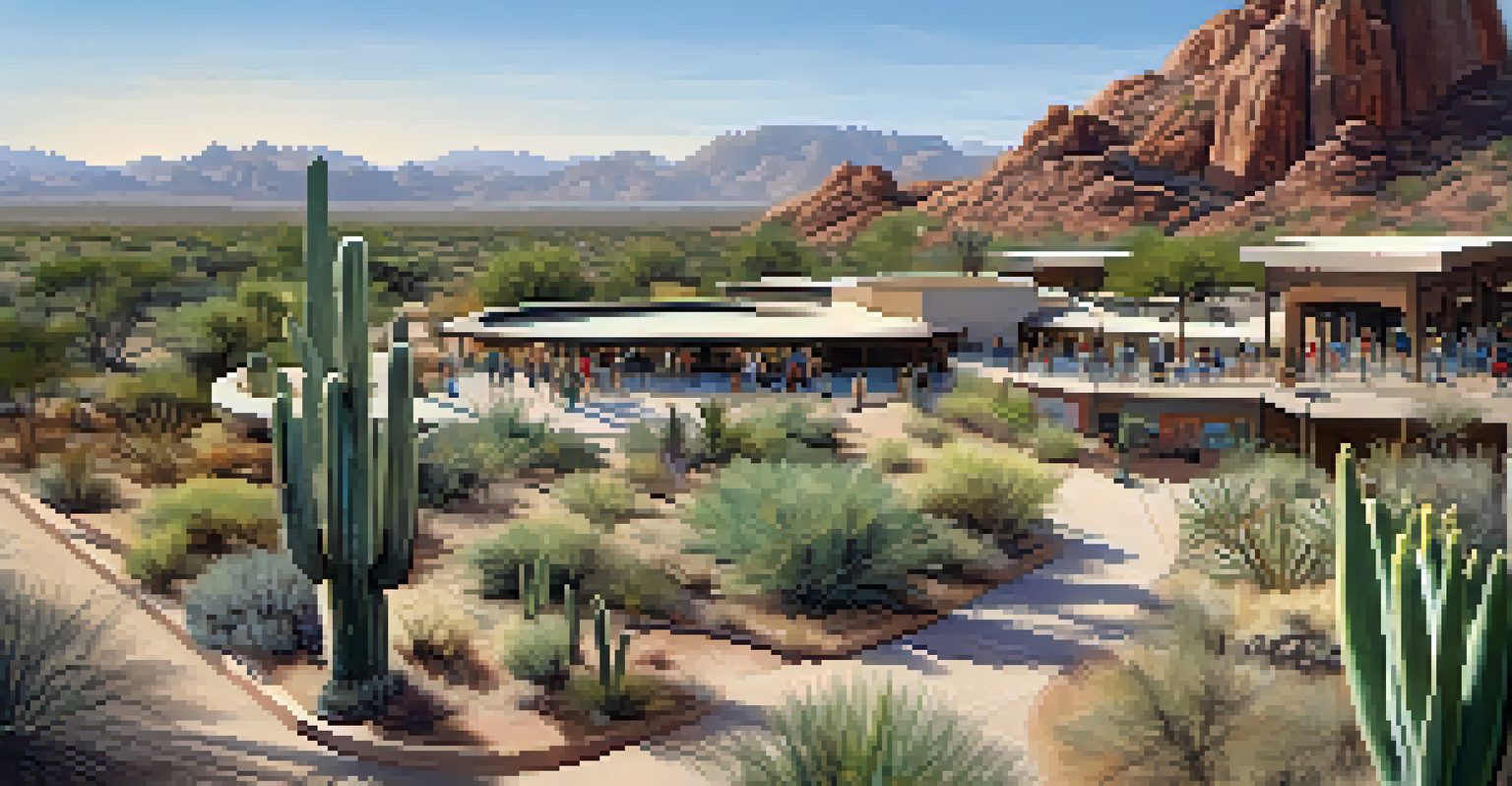Unveiling the Rich History of Tucson's Historic Landmarks

The Origins of Tucson: A Glimpse into Its Early Days
Tucson's history dates back to its establishment as a Spanish presidio in 1775. This military outpost was crucial for protecting Spanish settlers and trade routes, laying the foundation for what would become a vibrant city. The blending of cultures in Tucson set the stage for its unique identity.
History is not a burden on the memory but an illumination of the soul.
As the years progressed, Tucson evolved into a bustling center of trade and agriculture. The arrival of the railroad in the late 1800s further accelerated its growth, connecting it to larger markets and encouraging an influx of settlers. This period marked a significant transformation in the city’s landscape and economy.
Today, remnants of Tucson's past can be seen in its historic landmarks, which tell stories of resilience and adaptation. Understanding these origins helps us appreciate the city’s character and the diverse influences that shaped it into the lively place it is now.
The Iconic Mission San Xavier del Bac: A Testament to Faith
Mission San Xavier del Bac, often referred to as the 'White Dove of the Desert,' is one of Tucson’s most cherished landmarks. Founded in 1692 by Spanish Jesuits, this stunning mission is known for its exquisite architecture and rich history. Its striking white façade and intricate interior murals draw visitors from all around.

This mission not only serves as a place of worship but also as a testament to the cultural blend of Native American and European influences. The ongoing restoration efforts have preserved its beauty and historical significance for future generations. It stands as a proud symbol of Tucson’s rich heritage.
Tucson's Rich Cultural Heritage
Tucson's unique identity stems from the blending of Native American, Spanish, and Mexican cultures, which shapes its art, music, and festivals.
Visiting San Xavier del Bac offers a unique experience where history and spirituality intertwine. For many, it’s more than just a landmark; it’s a journey into the heart of Tucson’s past, reflecting the community’s enduring faith and connection to its roots.
The Historic El Presidio District: A Walk Through Time
The El Presidio District is Tucson’s oldest neighborhood, brimming with history and charm. This area was once the site of the original Spanish fort, and today, it features a blend of historic adobe structures and modern shops. Walking through its streets feels like stepping back in time.
Preservation is the key to our past, our present, and our future.
As you explore, you’ll encounter beautifully preserved buildings like the Pima County Courthouse and the Sosa-Carrillo-Fremont House. Each structure has its own story, reflecting the evolution of Tucson from a frontier town to a modern city. These sites showcase the architectural diversity and cultural richness of the region.
El Presidio is not just about its landmarks; it’s also a hub for community events and festivals. This vibrant atmosphere makes it a perfect spot for locals and visitors alike to connect with Tucson’s history while enjoying its lively present.
The Arizona-Sonora Desert Museum: Nature Meets Culture
The Arizona-Sonora Desert Museum is more than just a museum; it’s an immersive experience that highlights the beauty of the Sonoran Desert. Established in 1952, this unique institution combines a zoo, botanical garden, and natural history museum, showcasing the region’s diverse flora and fauna.
Visitors can explore outdoor exhibits featuring native wildlife, like coyotes and javelinas, while learning about the desert's fragile ecosystem. The museum also offers insights into the cultural heritage of the area, including the traditions of Native American tribes. It's a place where nature and history intertwine.
Historic Landmarks Tell Tucson's Story
The preservation of Tucson's historic landmarks is essential for maintaining its cultural identity and providing future generations with a glimpse into the past.
This landmark serves as a reminder of the importance of conservation and understanding our environment. By visiting, you not only learn about Tucson’s natural wonders but also gain a deeper appreciation for the cultural narratives that have shaped this remarkable region.
The Pima Air & Space Museum: A Journey Through Aviation History
For aviation enthusiasts, the Pima Air & Space Museum is a must-visit landmark in Tucson. Home to over 350 aircraft, it showcases the evolution of flight from the early days of aviation to modern space exploration. The museum’s vast collection tells the story of human ingenuity and the quest for flight.
Visitors can explore a wide range of aircraft, including military planes, commercial jets, and even a space shuttle. Each exhibit is meticulously curated, providing insights into the technology and innovation that have defined aviation history. It’s an engaging experience for both children and adults alike.
The museum also offers guided tours and educational programs, making it an ideal destination for families and school groups. By visiting the Pima Air & Space Museum, you not only witness aviation history but also inspire the next generation of dreamers and innovators.
The Historic Hotel Congress: A Glimpse into the Past
The Hotel Congress is a historic landmark that captures the spirit of Tucson's past. Built in 1919, it has hosted numerous notable guests, including the infamous John Dillinger, who was captured here in 1934. This hotel is a fascinating blend of history and modernity, making it a popular spot for both locals and tourists.
With its charming architecture and vibrant atmosphere, the Hotel Congress offers a taste of Tucson's rich cultural scene. The hotel features a lively bar and restaurant where you can enjoy live music and local cuisine. It’s a place where history and hospitality come together seamlessly.
The Role of Community in Preservation
Local organizations and community efforts play a vital role in restoring and protecting Tucson's historic sites, ensuring their stories endure.
Staying at the Hotel Congress or even just visiting allows you to experience the allure of Tucson's past while enjoying contemporary comforts. Each corner of the hotel holds a story, inviting guests to step into the pages of history while savoring the present.
The Influence of the Old Pueblo on Local Culture
Tucson, often referred to as the 'Old Pueblo,' has a rich cultural heritage that deeply influences its local customs and traditions. The blend of Native American, Spanish, and Mexican cultures creates a unique tapestry that is reflected in the city’s art, music, and festivals. This cultural fusion is a vital part of what makes Tucson special.
Local events, such as the All Souls Procession and the Tucson Meet Yourself Festival, celebrate this diversity and bring the community together. These gatherings showcase traditional music, dance, and culinary delights, allowing residents and visitors to experience Tucson’s vibrant culture firsthand. They are opportunities to honor the city’s history while embracing its modern spirit.

Understanding the cultural influences of Tucson helps foster a sense of connection among its residents. It reminds us that the city's history is not just about landmarks; it's also about the people and traditions that continue to shape its identity today.
Preserving Tucson's Historic Landmarks for Future Generations
As Tucson continues to grow and evolve, the preservation of its historic landmarks becomes increasingly important. These sites offer a glimpse into the past and serve as a reminder of the city’s rich heritage. Community efforts and local organizations work tirelessly to protect these treasures from the pressures of modernization.
Preservation initiatives often involve restoring old buildings, educating the public about their significance, and promoting sustainable tourism. By engaging the community, these efforts ensure that the stories of Tucson’s landmarks endure for future generations to appreciate and learn from. Each preserved site serves as a chapter in the ongoing narrative of the city.
Visitors are encouraged to participate in these preservation efforts by exploring and supporting local historic sites. By valuing Tucson's history, we help safeguard its cultural identity, ensuring that the stories of the past continue to inspire the future.